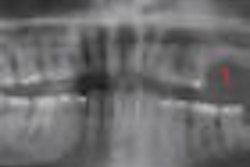
Many impression materials have antimicrobial properties, but dental practitioners may be relying on them to prevent cross-contamination more than they should, according to a study in Quintessence International (November/December 2011, Vol. 42:10, pp. e124-e130).
Researchers from Tel Aviv University compared four different antimicrobial impression materials and found that none offers a complete, long-lasting antibacterial or antifungal property.
Dental impression materials may carry various microbial pathogens such as bacteria, viruses, and fungi that are found in the oral cavity, according to the study authors. Unless these materials possess effective antibacterial properties, they can be a potential source of cross-contamination and therefore a health hazard, they noted.
"Current infection control protocols require that impressions be thoroughly cleaned and disinfected after setting," the researchers wrote. "Compliance with these requirements is low among dentists, and only 50% of laboratories have a cross-infection policy."
They attributed noncompliance to dentists banking on the antibacterial/antifungal properties of the materials they use to prevent cross-contamination.
4 commercial products
The research team tested four commercially available impression materials: Orthoprint, a irreversible hydrocolloid (Zhermack); Impregum Penta, a polyether (3M ESPE); Aquasil Ultra Monophase Fast Set Smart Wetting, an additional silicone (Dentsply); and Permlastic, a polysulphide (Kerr). Each was used in accordance with the manufacturers' instructions.
The test microorganisms were Enterococcus faecalis G strain, Staphylococcus aureus Oxford strain, Staphylococcus epidermidis RP62A, and Candida albicans 58919. The researchers employed the quantitative direct contact test to evaluate the microorganisms' interaction with the materials.
“Antimicrobial properties cannot replace disinfection.”
— Julia Farr, PhD, 3M ESPE
Each material was examined immediately after setting at 24, 48, and 72 hours and one week. The materials were tested in octet, with the microorganisms brought into direct contact for 60 minutes after which a growth medium was added. These steps were performed using a 96-well microtiter plate, which was vortexed for two minutes and inserted into a temperature-controlled spectrophotometer after the growth material had been added.
When the combined interaction of material, microorganism, and time was assess by two-way analysis of variance (ANOVA) for each bacterium/fungi, the researchers found each to be statistically significant (p < 0.01).
While none of the materials offers a complete, long-lasting antibacterial or antifungal property, 3M's Impregum Penta had the broadest antibacterial spectrum compared with the other materials tested, they found. This material demonstrated a minor inhibitory effect on E. faecalis immediately after material setting and had a significant effect on S. epidermidis and S. aureus. It also had a minor effect on C. albicans immediately after setting for up to 48 hours.
Aquasil Ultra performed similarly against C. albicans, the study authors noted. It had a minor impact on S. aureus growth and no inhibitory effect on E. faecalis and S. epidermidis.
Orthoprint did not affect the growth rate of S. epidermidis and E. faecalis relative to the control group, and had a minor inhibitory effect on C. albicans and an encouraging effect on the growth rate of S. aureus for at least seven days, the researchers found.
Permlastic only had an inhibitory effect on the growth of C. albicans, they noted.
"With the limitations of an in vitro study, it can be concluded that none of the tested dental impression materials exhibited a complete bacteriocidic or fungicidic effect," they wrote.
Disinfection protocols critical
The researchers also suggested that, due to low compliance with infection control protocols, manufacturers should pay more attention to developing materials that possess antibacterial and antifungal capabilities.
While antimicrobial properties might be an additional helpful feature of impression materials, "they cannot replace disinfection," said Julia Farr, PhD, scientific affairs manager at 3M ESPE.
Impregum meets the requirements for medical devices class I and is not meant to be used on open wounds, Farr added.
"Though antibacterial properties might be an additional beneficial property, we do not see this as the highest priority for the given reasons," she said.
3M ESPE's Impregum and Imprint 3 intraoral syringes can help prevent cross-contamination from the mouth to the Garant guns because the syringes are designed for one-time usage and can be loaded in advance, Farr added.
"The Garant gun will never come in the vicinity of the mouth, leading to improved hygiene," she said.
Based on the study findings, the authors urge clinicians to clean, disinfect, and rinse all dental prostheses and prosthodontic materials using an Environmental Protection Agency (EPA)-registered hospital disinfectant before handling them in the laboratory.



















